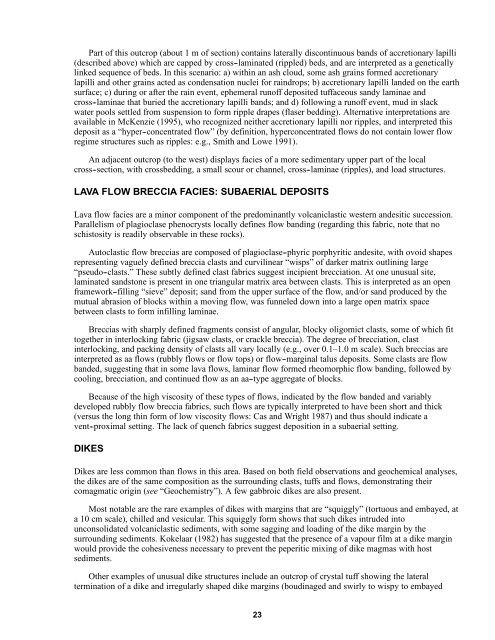Regional Geology, Sioux Lookout Orogenic Belt - Geology Ontario
Regional Geology, Sioux Lookout Orogenic Belt - Geology Ontario
Regional Geology, Sioux Lookout Orogenic Belt - Geology Ontario
You also want an ePaper? Increase the reach of your titles
YUMPU automatically turns print PDFs into web optimized ePapers that Google loves.
Part of this outcrop (about 1 m of section) contains laterally discontinuous bands of accretionary lapilli<br />
(described above) which are capped by cross--laminated (rippled) beds, and are interpreted as a genetically<br />
linked sequence of beds. In this scenario: a) within an ash cloud, some ash grains formed accretionary<br />
lapilli and other grains acted as condensation nuclei for raindrops; b) accretionary lapilli landed on the earth<br />
surface; c) during or after the rain event, ephemeral runoff deposited tuffaceous sandy laminae and<br />
cross--laminae that buried the accretionary lapilli bands; and d) following a runoff event, mud in slack<br />
water pools settled from suspension to form ripple drapes (flaser bedding). Alternative interpretations are<br />
available in McKenzie (1995), who recognized neither accretionary lapilli nor ripples, and interpreted this<br />
deposit as a “hyper--concentrated flow” (by definition, hyperconcentrated flows do not contain lower flow<br />
regime structures such as ripples: e.g., Smith and Lowe 1991).<br />
An adjacent outcrop (to the west) displays facies of a more sedimentary upper part of the local<br />
cross--section, with crossbedding, a small scour or channel, cross--laminae (ripples), and load structures.<br />
LAVA FLOW BRECCIA FACIES: SUBAERIAL DEPOSITS<br />
Lava flow facies are a minor component of the predominantly volcaniclastic western andesitic succession.<br />
Parallelism of plagioclase phenocrysts locally defines flow banding (regarding this fabric, note that no<br />
schistosity is readily observable in these rocks).<br />
Autoclastic flow breccias are composed of plagioclase--phyric porphyritic andesite, with ovoid shapes<br />
representing vaguely defined breccia clasts and curvilinear “wisps” of darker matrix outlining large<br />
“pseudo--clasts.” These subtly defined clast fabrics suggest incipient brecciation. At one unusual site,<br />
laminated sandstone is present in one triangular matrix area between clasts. This is interpreted as an open<br />
framework--filling “sieve” deposit; sand from the upper surface of the flow, and/or sand produced by the<br />
mutual abrasion of blocks within a moving flow, was funneled down into a large open matrix space<br />
between clasts to form infilling laminae.<br />
Breccias with sharply defined fragments consist of angular, blocky oligomict clasts, some of which fit<br />
together in interlocking fabric (jigsaw clasts, or crackle breccia). The degree of brecciation, clast<br />
interlocking, and packing density of clasts all vary locally (e.g., over 0.1–1.0 m scale). Such breccias are<br />
interpreted as aa flows (rubbly flows or flow tops) or flow--marginal talus deposits. Some clasts are flow<br />
banded, suggesting that in some lava flows, laminar flow formed rheomorphic flow banding, followed by<br />
cooling, brecciation, and continued flow as an aa--type aggregate of blocks.<br />
Because of the high viscosity of these types of flows, indicated by the flow banded and variably<br />
developed rubbly flow breccia fabrics, such flows are typically interpreted to have been short and thick<br />
(versus the long thin form of low viscosity flows: Cas and Wright 1987) and thus should indicate a<br />
vent--proximal setting. The lack of quench fabrics suggest deposition in a subaerial setting.<br />
DIKES<br />
Dikes are less common than flows in this area. Based on both field observations and geochemical analyses,<br />
the dikes are of the same composition as the surrounding clasts, tuffs and flows, demonstrating their<br />
comagmatic origin (see “Geochemistry”). A few gabbroic dikes are also present.<br />
Most notable are the rare examples of dikes with margins that are “squiggly” (tortuous and embayed, at<br />
a 10 cm scale), chilled and vesicular. This squiggly form shows that such dikes intruded into<br />
unconsolidated volcaniclastic sediments, with some sagging and loading of the dike margin by the<br />
surrounding sediments. Kokelaar (1982) has suggested that the presence of a vapour film at a dike margin<br />
would provide the cohesiveness necessary to prevent the peperitic mixing of dike magmas with host<br />
sediments.<br />
Other examples of unusual dike structures include an outcrop of crystal tuff showing the lateral<br />
termination of a dike and irregularly shaped dike margins (boudinaged and swirly to wispy to embayed<br />
23

















